Paul K. Guillow, Inc.
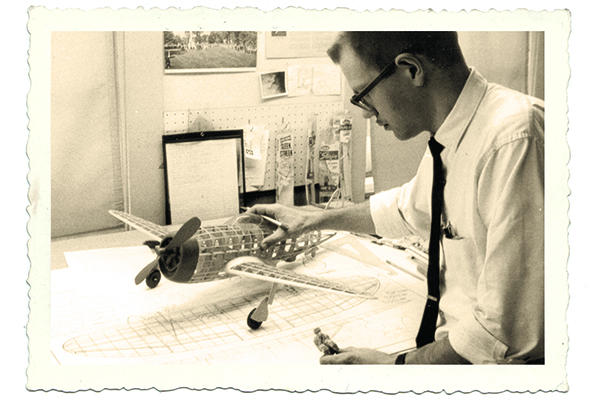
Written by Don DeLoach Ninety years of model aviation As seen in the April 2016 issue of Model Aviation.
Submitted photos
Thank you to everyone who has helped us celebrate Guillow's 90th anniversary by uploading a photo an a short story. We've enjoyed reading them and are excited to share! Click each photo to see a larger version and read what the owner had to say about the model. Please note that we are no longer accepting new submissions for this gallery.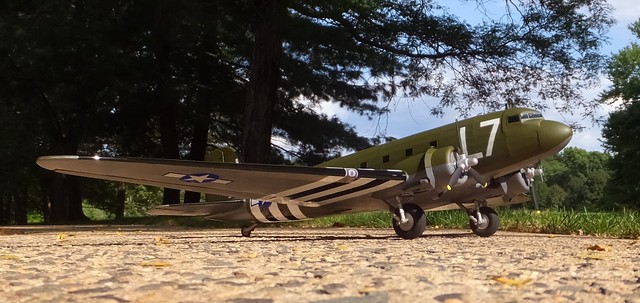
A name synonymous with stick-and-tissue model aircraft for generations, the Paul K. Guillow company in Wakefield, Massachusetts, is celebrating 90 years in business in 2016. The company was originally founded by Paul Guillow (rhymes with willow) in 1926 as NuCraft Toys. Born in 1893, Paul Guillow was a World War I naval veteran who brought home from Europe an abiding love for the burgeoning technology of aviation. Paul founded his aviation-themed toy business at the perfect time: one year before Charles Lindbergh ignited a worldwide craze following his 1927 transatlantic solo flight. Paul seized on this event by introducing his successful card game, The Lindy Flying Game. NuCraft’s first model airplane product was a line of small balsa static models of combat aircraft flown in the war. Another shift followed when Paul recognized a high demand for flying models, and expanded the line to Free Flight (FF) rubber-powered scale and glider kits. In 1933, Paul moved the expanding company from his barn into the present headquarters on Salem Street in Wakefield, a hamlet approximately 12 miles outside of Boston. In the 1940s, Paul—by then an expert on model aircraft—wrote several books, including Tom’s Book of Flying Models and Flying Models: How to Build Them. Paul died in 1951, but the company continued to thrive under the leadership of his widow, Gertrude. For 35 years Guillow’s was family-owned and operated, until it was finally transferred to an Employee Stock Ownership Plan, with annual revenues between $3 and $5 million as of 2010.
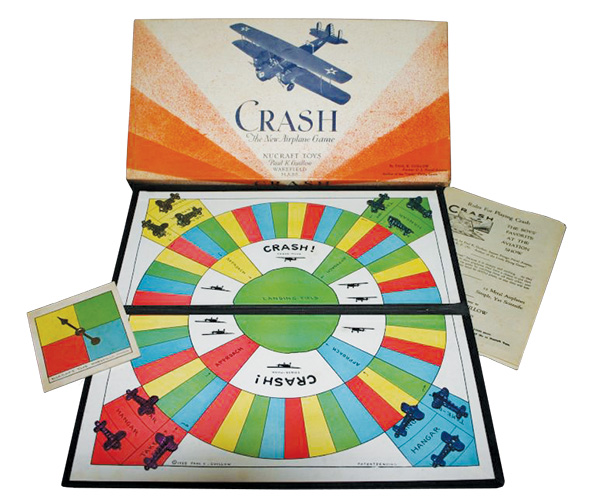
The board game, Crash The New Airplane Game, was released by NuCraft Toys in 1928. NuCraft Toys ended in 1933 when the company name was changed to Paul K. Guillow, Inc.
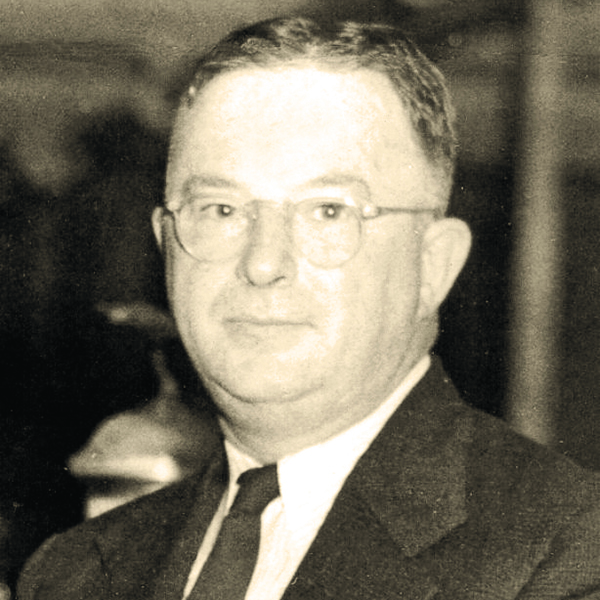
Paul Guillow was a naval veteran of World War I who brought home from Europe an abiding love for the burgeoning technology of aviation. Photo courtesy of Guillow’s.
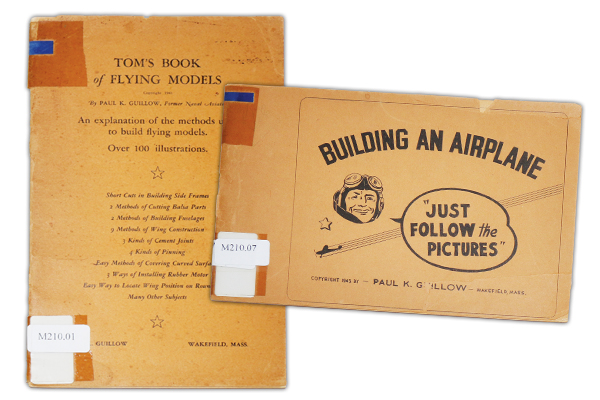
Tom’s Book of Flying Models and Flying Models: How to Build Them were written by Paul Guillow. These copies are part of the National Model Aviation Museum’s collection. Photo by Jennifer Alderman.
Most Guillow’s kits are old-fashioned balsa and tissue, just as they were 80 years ago. Plastic propellers, vacuumed-formed spinners, and molded canopies were upgrades in the 1960s, but since then, little has changed. Most kits are scale models in the 16- to 35-inch wingspan range and most are designed for FF. Guillow’s is proud to use plantation-grown balsa imported directly from Ecuador, and the company is quick to note that the harvesting process is kind to the rain forest. It is also proud to state that all of its products (except for a small foam helicopter toy) are made in Wakefield. By the mid-1990s, Guillow’s was gobbling up its competition, acquiring Tiger, Inc. in Los Angeles and Comet of Chicago. Tiger was a leader in promotional flying toys imprinted with company names and graphics; Comet was a direct competitor in balsa kits and gliders. Guillow’s is still on Salem Street in Wakefield. The factory complex has gradually expanded, but today continues to use many of its original Depression-era tools. The recent upgrade of a laser cutter has brought Guillow’s kits into the 21st century. Now the balsa parts are accurate and true-fitting, making the kits easier to build.
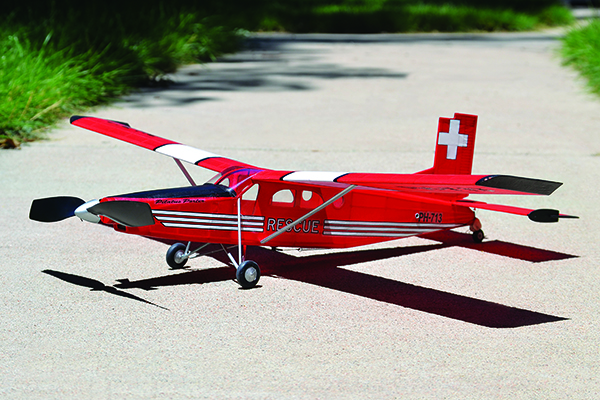
The author’s Guillow’s PC-6 Porter, which was reviewed in the October 2013 issue of Model Aviation.
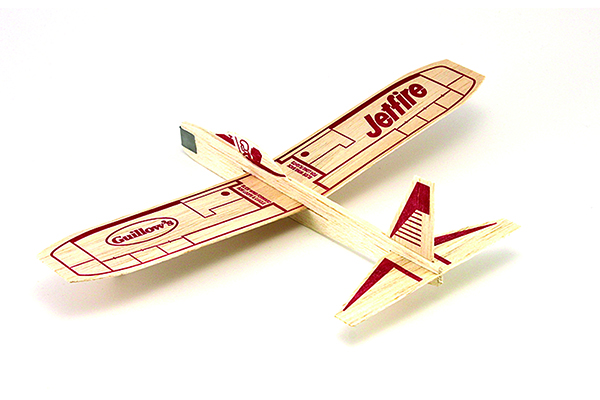
Simple balsa models such as this Jetfire gave many children their first model airplane experience.

In 1933, Paul Guillow moved his expanding company from his barn into its present headquarters on Salem Street in Wakefield MA, a hamlet roughly 12 miles outside of Boston. Photo courtesy of Guillow’s.
As every model builder knows, balsa airplane models are fragile. For some they are too fragile—thus, they fail to deliver on expectations. This infamous 1959 letter by disgruntled customer Robert Higgins still hangs in Guillow’s Wakefield office: “I have bought one of your fifty cent planes, and it broke as soon as it left the ground. If you don’t make your rotten fifty cent plane better, my friends & I won’t buy your planes anymore. I think you have the lousiest planes from the lousiest wood (please take this as an insult): drop dead.” Maybe poor Robert was ham-handed, or didn’t have a good mentor, or both. Now, in 2016, Guillow’s has 69 stick-and-tissue kits in its catalog and several dozen slide-together flying toys. Many of the designs are unchanged from 50-plus years ago, save for laser-cutting upgrades and other small tweaks. A few surprises have been revealed in the 2016 catalog, including some new designs capable of contest-winning performance, and some static models (even jets) that offer jaw-dropping realism.










13 comments
Thanks for the article
Super Cub 95
Guillow's Slip-Together Flying Toys for Beginning Aeromodelers
I'm building a Guillows Cessna 180 right now
Guillows over the years
Guillow’s 90th Anniversary
Started as a young builder...
Missing items
I bought a kit 505
I bought a kit 505
Lost parts
Guillows WW1 Series 101 DC 18" wing spans
seeking knowledge
Add new comment